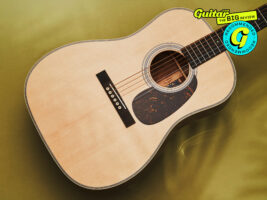
Martin O’ahu HG-28 review: “this is an instrument with its own distinct personality”
$3,599/£3,799, martinguitar.com
How many times have we been told that the Dreadnought acoustic guitar was originally created for country stars, folkies and singing cowboys? Chris Martin IV himself is at pains to put this misconception to bed because – as he explained to me in a recent conversation for the Martin Journal – everything actually started in Hawaii.
READ MORE: Furch Pioneer MM Review: “the biggest compliment that you can give to a travel guitar is that it doesn’t feel like one”
The resonator guitar, lap steel and even the earliest electric guitars were created for Hawaiian music – the first dreadnoughts made by Martin under the Ditson brand name were no exception. So why don’t we talk about it more?
Image: Adam Gasson
Martin O’ahu HG-28 – what is it?
This new Martin guitar – named the O’ahu HG-28 – is a Hawaiian koa and spruce beauty designed to go some way towards correcting that imbalance. As well as being the first guitar from Martin’s new O’ahu sub-brand, it also celebrates the significant impact that the tiny Hawaiian archipelago has had on popular music since the explosion in popularity that followed the 1915 Panama-Pacific International Exposition. After this World’s Fair event was held in San Francisco, suddenly aloha shirts, ukuleles and slack key tuned guitars were popping up everywhere.
This particular guitar would not exist without a surreal moment of serendipity when Chris Martin IV found an unusual instrument in an online auction and couldn’t resist giving it a home.
The guitar in question was one of the more improbable Gibson models of the time – the HG-2O which featured among its bizarre specs, an internal resonating chamber and additional F-holes in both the upper and lower bouts. Utterly bonkers and ultimately an evolutionary dead end for the flat-top acoustic.
But when CFMIV checked out his new vintage purchase – complete with a soundboard that had all but collapsed over the years – he realised that the guitar was essentially a round- shouldered dreadnought for Hawaiian music.
It set Chris to imagining what a similar Martin guitar might look like – an evolutionary missing link between those original Ditson dreadnoughts and the all-conquering Martin models that would come along in the 30s. This was the spark of inspiration that led – after much research and development – to the O’ahu HG-28 I am now holding in my hands.
Image: Adam Gasson
But the HG-28 is more than just an interesting alternative history lesson – it has plenty of intriguing qualities on its own merits for those who maybe don’t quite get on with Martin’s most famous and influential design.
Despite the majestic power that typifies its voice, some will tell you – with a straight face! – that the traditional Martin dreadnought design is too boomy. The body is too big, it is uncomfortable, they will claim.
Well, thanks to the HG-28, dreadnought-curious players can now enjoy a more ergonomically svelte experience. The gently slope-shouldered body is no deeper than a Martin 000 and feels good when seated. The guitar is built around a shorter 24.9” scale length too which promises added warmth and intimacy if that’s what you’re looking for.
Koa is an interesting wood – it was a traditional choice for ukuleles (it only grows in Hawaii after all) – and Martin pioneered its use for acoustic guitars in the 1920s. Nowadays it’s often seen as an attractive, if pricey, alternative to rosewood or mahogany – one that has seen heavy use in recent years by Martin’s great modern rival, Taylor.
Koa is loved for its beautiful figure and timbral properties that mean it pairs very well with good spruce. As luck would have it the lid of this box is made from a slice of pale Sitka – a classic choice that looks striking against the top’s herringbone purfling and cream binding.
Some might raise eyebrows at a £3.5k guitar shipping without a hard case, but the softshell gigbag included still feels very premium with generous padding, a robust neck support and a rather fetching woven fawn-coloured outer covering.
Image: Adam Gasson
Martin O’ahu HG-28 – feel and sounds
Pulling the HG-28 out of said gigbag, and it’s instantly a very welcoming experience. The neck features Martin’s Low Oval High Performance Taper and is made from what Martin frustratingly vaguely describes as ‘Select Hardwood’. In this case it certainly looks like something mahogany-coded with some spectacular grain accentuated with dark pore filler. It’s an immediately comfortable squeeze – fast and familiar. The 1.75” nut width offers enough room for fingerstyle too.
While a short-scale slope-shoulder dreadnought could feel very like a Gibson J-45, the whole vibe of the O’ahu HG-28 is reassuringly Martin from the arm position on the lower bout to the balance point at the waist. Time to make some noise!
I honestly hadn’t planned to stay in standard EADGBE for very long with this guitar – I was extremely keen to get involved with some of the naughtier slack key tunings I’ve encountered over the years. However this is actually a very workable little dreadnought in missionary tuning and it could prove a useful alternative to a D-18 or D-28 – especially in the studio.
With bare fingers the HG-28 has a sweet voice – Martin supply the guitar with uncoated strings so there is an element of extraneous string noise, but the koa back and sides are more forgiving than a rosewood instrument might be.
Taking a medium flatpick to the guitar certainly wakes it up. The bass response – though definitely present – is not quite the full 25.4” scale bark of a D-28 but there is more than enough punch for a convincing G-run and the trebles are smooth and balanced all the way up the fretboard.
Easing the O’ahu HG-28 into DADGAD reveals a woody, fundamental quality to the voice – this helps prevent the sympathetic resonances typical of that tuning from getting muddy or indistinct and the short scale makes wider vibrato and bends a genuine pleasure.
The guitar has played a fascinating role in the history of Hawaiian music and kī hōʻalu or slack key playing is at the heart of it. Taro Patch tuning – known to the rest of the world as Open G – reveals a lot about the character of this instrument – that koa shimmer across the shorter scale length, the slightly metallic transient to the note that is so typical of sitka spruce. These are subtleties but there is no denying that this is an instrument with its own distinct personality.
Image: Adam Gasson
Martin O’ahu HG-28 – should I buy one?
With the new O’ahu HG-28 Martin has a very interesting proposition on its hands. Whether you’re into the Hawaiian vibe or not – where else are you going to find a koa slope-shoulder short scale dread at this price point?
It is evident that a lot of thought has gone into this instrument – but more than that – the O’ahu HG28 represents an acknowledgement of the role of Hawaiian culture in modern popular music. There is a beautiful Hawaiian concept of ‘pono’ – the word means righteous, balanced, good. From beautifully figured koa to the palm trees on the label and the correct reverse apostrophe in O’ahu this is a very pono guitar.
Image: Adam Gasson
Martin O’ahu HG-28 – alternatives
The HG-28 is very much doing its own thing in terms of design and sound, but there are some fine koa-based acoustics out there that show off this fine wood for various budgets. Taylor’s Academy 10e LTD ($999) is a Mexico-made dreadnought that apes the HG’s blend of spruce top with a Hawaiian koa back and sides. Dana Bourgeois is one of the world’s finest acoustic luthiers and his transnational Touchstone series brings his wares to slightly more accessible price points. The limited edition Hawaiian Country Boy D ($3,149) utilises koa back and sides with a spruce top tuned and selected in Main. If money’s no object and you really want to go all out, Turnstone’s TD Koa and Sitka (from £8,500) is pretty much as good as it gets.
The post Martin O’ahu HG-28 review: “this is an instrument with its own distinct personality” appeared first on Guitar.com | All Things Guitar.
Source: www.guitar-bass.net













